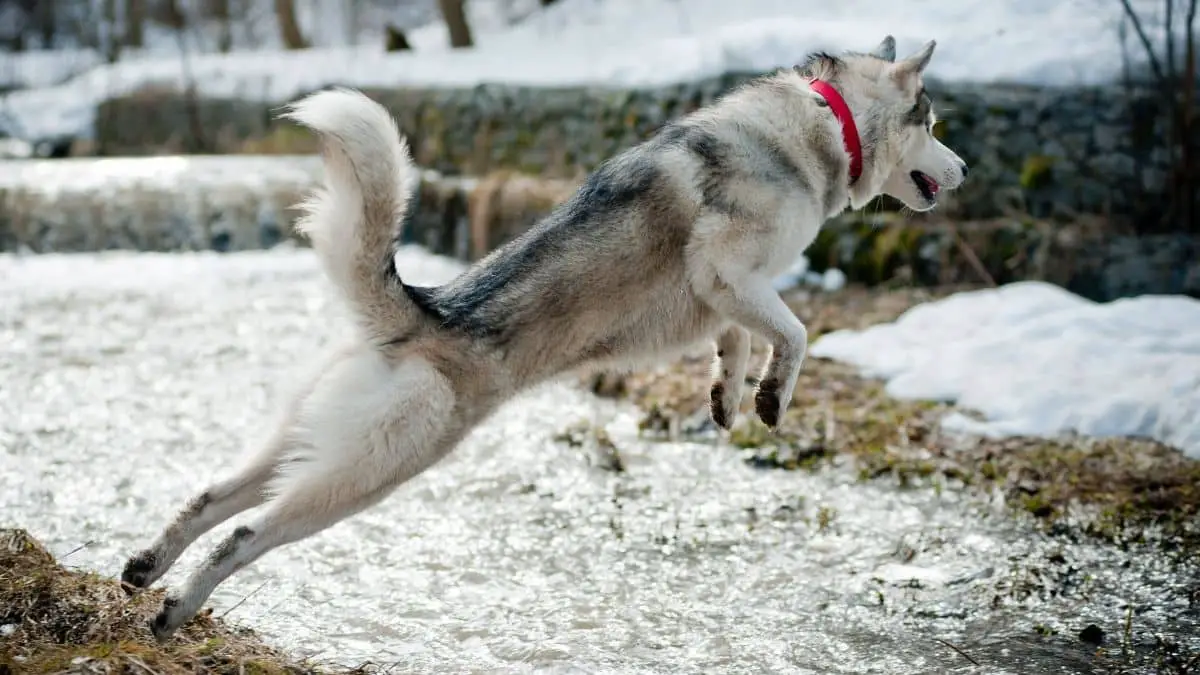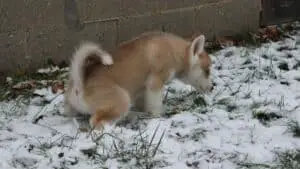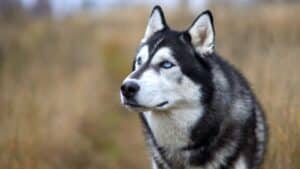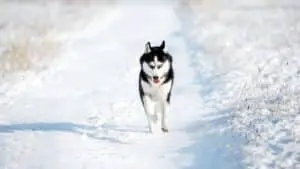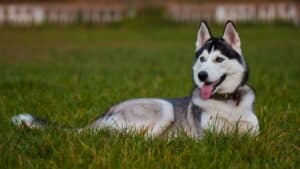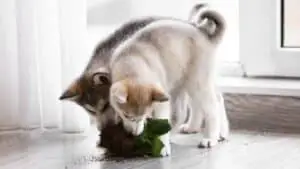Siberian Husky Jumping – Is It A Problem?
It’s one of the highlights of a dog owner’s day: you get home from a long day at work, and your beloved pup starts to jump all over you. However, how do you know when this jumping behavior crosses the line? Certainly, when your Siberian Husky grows up, you don’t want his way of saying hello to knock someone flat on their back!
There is a myriad of reasons why your Siberian Husky is jumping all over you. Often, he is simply happy and excited to see you and – just like humans – wants to give you his version of a hug! In other scenarios, your Husky may be trying to assert his dominance – a tendency you may not want to encourage. Another reason your Husky jumps is that he might be trying to escape your backyard, in which case I hope you have a large fence!
Although jumping is certainly not a bad behavior in and of itself, it can be intimidating for a guest if a large Husky dog begins to jump all over them! It can also be frustrating if your Husky’s excessive excitement levels means that he wants to jump all over your furniture! You can train your Husky the right way to greet guests and encourage him to moderate his jumping behavior to save your couch.
Table of Contents
Is jumping really a problem?
When a Husky begins to jump on people to say hello, he will usually place his front paws on their body and wag his tag enthusiastically.
This type of body language indicates that he is happy and content and that he is simply glad to see them. For those unfamiliar with dogs, this could be a frightening experience, however.
In this situation, you should not punish your Husky for his enthusiastic greeting. Rather, demonstrate the correct way to greet guests by using some of the training methods and means that you have already taught your Husky.
Another type of jumping that Husky owners will be familiar with comes in the form of the “zoomies”. This is when your Husky energy and excitement levels seem to go through the roof, and he will start jumping and leaping from the floor to your furniture and back again.
Again, this behavior can be actively discouraged and trained out of your Husky if you know what you are doing!
The biggest concern when it comes to your Husky’s jumping behaviors is when he attempts to jump over your yard fence and escape. If your Husky is able to do this, he is putting himself at risk and may also disturb the neighborhood and local wildlife.
Teaching your Husky to say hello
To stop your Husky from jumping on people, you can use two of the most basic and familiar commands and training methods in existence: the sit command and your Husky’s crate.
Training your Siberian Husky not to jump on people begins with the ‘sit’ command. This can be used anywhere and is particularly useful when you and your Husky are out and about, mingling with other dogs and humans.
Before your Husky starts jumping on people or a person, issue the sit command. If he sits and does not jump, give him a treat. Do not give him the treat until he obeys you. Using firm pressure on the leash can help you here.
Preventing your Husky from jumping on people in your home is somewhat easier, as you can make use of his crate.
Have your dog in his crate while visitors arrive. After some time, when it is clear that he is calm, take him out of the crate and tell him to sit. Continue to issue the command until he complies. Your visitors should only give him treats and attention once he is seated. Repeat this process, making sure your guests stick firmly to the concept of positive reinforcement until it becomes second nature to them.
If you think your Siberian Husky is jumping on people to get attention, make sure you are spending quality time with him every day, petting and cuddling up with him. Shower him with necessary love and attention but not too much as to create problems with separation anxiety.
Stop your Husky from jumping on the couch
Similar to how you taught your Siberian Husky not to jump on people when he greets them, you can also encourage your Husky to stop jumping on the furniture by using the ‘sit’ command.
Whenever your Husky starts to leap on your furniture, firmly remove him, and tell him to sit instead. Reward him with a treat when he complies. You will need to do this every time he jumps on the furniture so he doesn’t become confused.
When can jumping be bad?
If your Siberian Husky jumps to assert his dominance, it is best that you enroll him in obedience school. This is a risky behavior that can put other parts of your training at risk, as it could mean that your Husky is less inclined to listen to you and obey you.
A jumping Husky can also be bad when he is trying to escape your yard by leaping over your fence! Huskies can jump quite high, and even a four-foot-high fence is unlikely to discourage them. Besides ensuring that your Husky has been exercised properly and is not escaping through boredom, the best way to prevent this behavior is by – you guessed it – building a bigger fence!
Frequently Asked Questions
How to keep your Husky from jumping over the fence?
One of the best ways to ensure that your Husky doesn’t leap over your yard fence and go exploring is to ensure that he has had plenty of exercise and mental stimulation throughout the day. Although Huskies do have a reputation as the Houdinis of the dog world and can leap over almost any obstacle you put in their way, if they are too tired to attempt the high jump, they simply won’t!
You will also need to be realistic and know that a small fence is unlikely to keep a Siberian Husky contained for long, no matter how much exercise he has had! Build a fence that he is unable to leap over – at least five feet high. Although you may not have the same beautiful views anymore, you can rest assured that your Siberian Husky is safe and sound at home with you.
Can Huskies jump high?
Huskies can jump very high. They are naturally athletic dogs, and most adult Huskies will be able to easily clear a four-foot fence. They may even be able to clear a six-foot fence through a combination of leaping and climbing.
Siberian Huskies’ instinctive tendency to be independent adventurers can sometimes get them and their owners in trouble. Huskies will naturally want to explore their surroundings and see your yard fence as a small obstacle to this desire!
Huskies are also a breed of dog with a strong prey drive. This means that they will tend to chase after any small animal they come across, especially if they are loose or off-leash. Be conscious of your Siberian Husky’s surroundings, and take the proper precautionary measures to prevent them running away from you.
Do Huskies jump on furniture?
As most Husky owners will attest, there comes a time on most days when your beloved Siberian Husky seems to be taken over by another force. Colloquially known as the “zoomies“, this mad dash between floor and furniture can somewhat alarming and more than a little annoying!
Zoomies, or to call them by their official name, Frenetic Random Activity Periods (FRAPS) usually come about as a way to release pent up energy. This can happen when your dog is unusually excited or alert or in some other state of heightened emotion.
Never chase your Husky if he has the zoomies. This will only encourage him, and you are very likely to only make things worse. Instead, monitor your dog’s behavior. If he tends to get the zoomies after a bath or when you take his leash out, try and control the physical environment before he jumps all over it!
For example, keep your dog’s leash in a more contained part of your house, where you can grab his collar and get him under control before he jumps all over every item of furniture in your home! Or, if you know your dog gets excited at a certain time of day or after a certain type of activity, take him out into the yard to blow off some steam.
Of course, the very best way to prevent your Husky from having too much pent up energy is by exercising him regularly and thoroughly. Remember, your Siberian Husky has his origins as a working dog and needs a lot more exercise than many other breeds.
Build playtime and exercise time into your schedule – take your Husky for a run or cycle, or use it as an opportunity to get out of the house and into nature.

